Absorption
 That portion of optical attenuation in optical fiber resulting from the conversion of optical power to heat. Caused by impurities in the fiber such as hydroxyl ions.
That portion of optical attenuation in optical fiber resulting from the conversion of optical power to heat. Caused by impurities in the fiber such as hydroxyl ions.
Acceptance Angle
 The half-angle of the cone (a) within which incident light is totally internally reflected by the fiber core. It is equal to sin-1(NA).
The half-angle of the cone (a) within which incident light is totally internally reflected by the fiber core. It is equal to sin-1(NA).
Angular Misalignment
![]() Loss at a connector due to fiber end face angles being misaligned.
Loss at a connector due to fiber end face angles being misaligned.
ANSI
Abbreviation for American National Standards Institute. An organization that administers and coordinates the U.S. voluntary standardization and conformity assessment system.
APC
Abbreviation for angled physical contact. A style of fiber optic connector with a 5°-15° angle on the connector tip for the minimum possible backreflection.
AR Coating
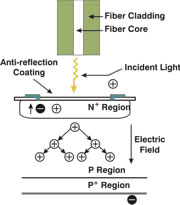 Antireflection coating. A thin, dielectric or metallic film applied to an optical surface to reduce its reflectance and thereby increase its transmittance.
Antireflection coating. A thin, dielectric or metallic film applied to an optical surface to reduce its reflectance and thereby increase its transmittance.
Armor
A protective layer, usually metal, wrapped around a cable.
ASCII
Abbreviation for American standard code for information interchange. An encoding scheme used to interface between data processing systems, data communication systems, and associated equipment.
ASTM
Abbreviation for American Society for Testing and Materials. An organization that provides a forum for the development and publication of voluntary consensus standards for materials, products, systems, and services that serve as a basis for manufacturing, procurement, and regulatory activities.
Attenuation
The decrease in signal strength along a fiber optic waveguide caused by absorption and scattering. Attenuation is usually expressed in dB/km.
Attenuation-Limited Operation
The condition in a fiber optic link when operation is limited by the power of the received signal (rather than by bandwidth or distortion).
AWG
A device, built with silicon planar lightwave circuits (PLC), that allows multiple wavelengths to be combined and separated in a dense wavelength-division multiplexing (DWDM) system.
Axial Propagation Constant
For an optical fiber, the propagation constant evaluated along the axis of a fiber in the direction of transmission.
Axis
Backreflection (BR)
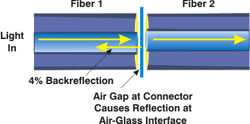 A term applied to any process in the cable plant that causes light to change directions in a fiber and return to the source. Occurs most often at connector interfaces where a glass-air interface causes a reflection.
A term applied to any process in the cable plant that causes light to change directions in a fiber and return to the source. Occurs most often at connector interfaces where a glass-air interface causes a reflection.
Backscattering
The return of a portion of scattered light to the input end of a fiber; the scattering of light in the direction opposite to its original propagation.
Bandwidth (BW)
The range of frequencies within which a fiber optic waveguide or terminal device can transmit data or information.
Bandwidth•Distance Product
Of an optical fiber, under specified launching and cabling conditions, at a specified wavelength, a figure of merit equal to the product of the fiber’s length and the 3 dB bandwidth of the optical signal. The bandwidth•distance product is usually stated in megahertz • kilometer (MHz•km) or gigahertz•kilometer (GHz•km). It is a useful figure of merit for predicting the effective fiber bandwidth for other lengths, and for concatenated fibers.
Bandwidth-limited Operation
The condition in a fiber optic link when bandwidth, rather than received optical power, limits performance. This condition is reached when the signal becomes distorted, principally by dispersion, beyond specified limits.
Beamsplitter
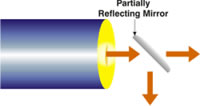 An optical device, such as a partially reflecting mirror, that splits a beam of light into two or more beams. Used in fiber optics for directional couplers.
An optical device, such as a partially reflecting mirror, that splits a beam of light into two or more beams. Used in fiber optics for directional couplers.
Bel (B)
The logarithm to the base 10 of a power ratio, expressed as: B = log10(P1/P2), where P1 and P2 are distinct powers. The decibel, equal to one-tenth bel, is a more commonly used unit.
Bend Radius
The smallest radius an optical fiber or fiber cable can bend before excessive attenuation or breakage occurs.
Bending Loss
Attenuation caused by high-order modes radiating from the outside of a fiber optic waveguide which occur when the fiber is bent around a small radius. See also macrobending, microbending.
Bidirectional
Operating in both directions. Bidirectional couplers operate the same way regardless of the direction light passes through them. Bidirectional transmission sends signals in both directions, sometimes through the same fiber.
BNC
Popular coax bayonet style connector, Often used for baseband video.
Bragg Grating
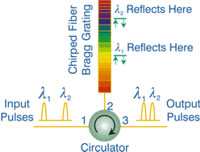 A technique for building optical filtering functions directly into a piece of optical fiber based on interferometric techniques. Usually this is accomplished by making the fiber photosensitive and exposing the fiber to deep UV light through a grating. This forms regions of higher and lower refractive indices in the fiber core.
A technique for building optical filtering functions directly into a piece of optical fiber based on interferometric techniques. Usually this is accomplished by making the fiber photosensitive and exposing the fiber to deep UV light through a grating. This forms regions of higher and lower refractive indices in the fiber core.
Buffer
1) In optical fiber, a protective coating applied directly to the fiber (illustrated). 2) A routine or storage used to compensate for a difference in rate of flow of data, or time of occurrence of events, when transferring data from one device to another.
Butt Splice
A joining of two fibers without optical connectors arranged end-to-end by means of a coupling. Fusion splicing is an example.
Bypass
The ability of a station to isolate itself optically from a network while maintaining the continuity of the cable plant.
c
Abbreviation for the speed of light. 299,792.5 km per second in a vacuum.
Cable
One or more optical fibers enclosed, with strength members, in a protective covering.
Cable Assembly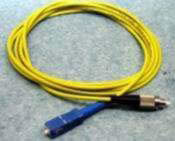
A cable that is connector terminated and ready for installation.
Cable Plant
 The cable plant consists of all the optical elements including fiber, connectors, splices, etc. between a transmitter and a receiver.
The cable plant consists of all the optical elements including fiber, connectors, splices, etc. between a transmitter and a receiver.
Chromatic Dispersion
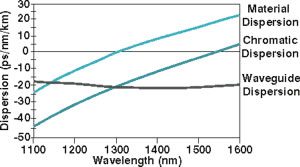 Reduced fiber bandwidth caused by different wavelengths of light traveling at different speeds down the optical fiber. Chromatic dispersion occurs because the speed at which an optical pulse travels depends on its wavelength, a property inherent to all optical fiber. May be caused by material dispersion, waveguide dispersion, and profile dispersion.
Reduced fiber bandwidth caused by different wavelengths of light traveling at different speeds down the optical fiber. Chromatic dispersion occurs because the speed at which an optical pulse travels depends on its wavelength, a property inherent to all optical fiber. May be caused by material dispersion, waveguide dispersion, and profile dispersion.
Cladding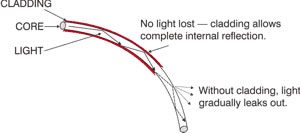
Material that surrounds the core of an optical fiber. Its lower index of refraction, compared to that of the core, causes the transmitted light to travel down the core.
Cladding Mode
A mode confined to the cladding; a light ray that propagates in the cladding.
Cleave
The process of separating an optical fiber by a controlled fracture of the glass, for the purpose of obtaining a fiber end, which is flat, smooth, and perpendicular to the fiber axis.
Coarse Wavelength-division Multiplexing (CWDM)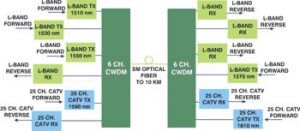
CWDM allows eight or fewer channels to be stacked in the 1550 nm region of optical fiber, the C-Band.
Coating
The material surrounding the cladding of a fiber. Generally a soft plastic material that protects the fiber from damage.
Coaxial Cable
 1) A cable consisting of a center conductor surrounded by an insulating material and a concentric outer conductor and optional protective covering. 2) A cable consisting of multiple tubes under a single protective sheath. This type of cable is typically used for CATV, wideband, video, or RF applications.
1) A cable consisting of a center conductor surrounded by an insulating material and a concentric outer conductor and optional protective covering. 2) A cable consisting of multiple tubes under a single protective sheath. This type of cable is typically used for CATV, wideband, video, or RF applications.
Coherent Communications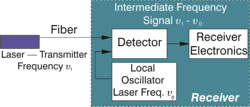
In fiber optics, a communication system where the output of a local laser oscillator is mixed optically with a received signal, and the difference frequency is detected and amplified.
Compression
A process in which the dynamic range or data rate of a signal is reduced by controlling it as a function of the inverse relationship of its instantaneous value relative to a specified reference level. Compression is usually accomplished by separate devices called compressors and is used for many purposes such as: improving signal-to-noise ratios, preventing overload of succeeding elements of a system, or matching the dynamic ranges of two devices. Compression can introduce distortion, but it is usually not objectionable.
Concatenation
The process of connecting pieces of fiber together.
Concentricity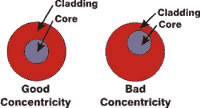
The measurement of how well-centered the core is within the cladding.
Connector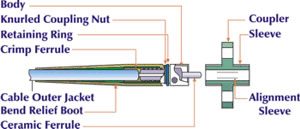
A mechanical or optical device that provides a demountable connection between two fibers or a fiber and a source or detector.
Connector Receptacle
The fixed or stationary half of a connection that is mounted on a panel/bulkhead. Receptacles mate with plugs.
Connector Variation
The maximum value in dB of the difference in insertion loss between mating optical connectors (e.g., with remating, temperature cycling, etc.). Also called optical connector variation.
Core
The light-conducting central portion of an optical fiber, composed of material with a higher index of refraction than the cladding. The portion of the fiber that transmits light.
Coupler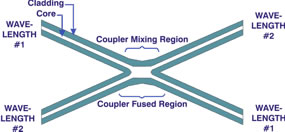
An optical device that combines or splits power from optical fibers.
Coupling Ratio/Loss (CR, CL)
The ratio/loss of optical power from one output port to the total output power, expressed as a percent. For a 1 x 2 WDM or coupler with output powers O1 and O2, and Oi representing both output powers:
Cutback Method
A technique of measuring optical fiber attenuation by measuring the optical power at two points at different distances from the test source.
Cutoff Wavelength
In single-mode fiber, the wavelength below which the fiber ceases to be single-mode.
Demultiplexer
A module that separates two or more signals previously combined by compatible multiplexing equipment.
Dense Wavelength-division Multiplexing (DWDM)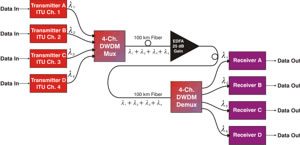
The transmission of many of closely spaced wavelengths in the 1550 nm region over a single optical fiber. Wavelength spacings are usually 100 GHz or 200 GHz which corresponds to 0.8 nm or 1.6 nm. DWDM bands include the C-Band, the S-Band, and the L-Band.
Dichroic Filter
An optical filter that transmits light according to wavelength. Dichroic filters reflect light that they do not transmit. Used in bulk optics wavelength-division multiplexers.
Dispersion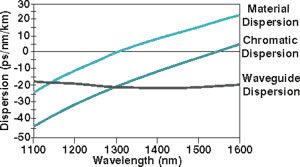
The temporal spreading of a light signal in an optical waveguide caused by light signals traveling at different speeds through a fiber either due to modal or chromatic effects.
Dispersion Management
A technique used in a fiber optic system design to cope with the dispersion introduced by the optical fiber. A dispersion slope compensator (illustrated) is one dispersion management technique.
Dispersion Penalty
The result of dispersion in which pulses and edges smear making it difficult for the receiver to distinguish between ones and zeros. This results in a loss of receiver sensitivity compared to a short fiber and measured in dB. The equations for calculating dispersion penalty are as follows:
Dispersion-compensating Fiber (DCF)
A fiber that has the opposite dispersion of the fiber being used in a transmission system. It is used to nullify the dispersion caused by that fiber.
Dispersion-compensating Module (DCM)
This module has the opposite dispersion of the fiber being used in a transmission system. It is used to nullify the dispersion caused by that fiber. It can be either a spool of a special fiber or a grating based module.
Dispersion-shifted Fiber (DSF)
A type of single-mode fiber designed to have zero dispersion near 1550 nm. This fiber type works very poorly for DWDM applications because of high fiber nonlinearity at the zero-dispersion wavelength.
Distribution System
Part of a cable system consisting of trunk and feeder cables used to carry signals from headend to customer terminals.
Dominant Mode
The mode in an optical device spectrum with the most power.
Dopant
An impurity added to an optical medium to change its optical properties. EDFAs use erbium as a dopant for optical fiber.
Dope
Thick liquid or paste used to prepare a surface or a varnish-like substance used for waterproofing or strengthening a material.
Double-window Fiber
1) Multimode fibers optimized for 850 nm and 1310 nm operation. 2) Single-mode fibers optimized for 1310 nm and 1550 nm operation.
Dual Attachment Concentrator
A concentrator that offers two attachments to the FDDI network which are capable of accommodating a dual (counter-rotating) ring.
Dual Attachment Station
A station that offers two attachments to the FDDI network which are capable of accommodating a dual (counter-rotating) ring.
Dual Ring (FDDI Dual Ring)
A pair of counter-rotating logical rings.
Duplex Cable
A two-fiber cable suitable for duplex transmission.
Duplex Transmission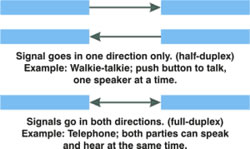
Transmission in both directions, either one direction at a time (half-duplex) or both directions simultaneously (full-duplex).
DWDM
See dense wavelength-division multiplexing.
E/O
![]() Abbreviation for electrical-to-optical converter. A device that converts electrical signals to optical signals, such as a laser diode.
Abbreviation for electrical-to-optical converter. A device that converts electrical signals to optical signals, such as a laser diode.
EDFA
See Erbium-doped fiber amplifier.
Effective Area
The area of a single-mode fiber that carries the light.
EIA
Abbreviation for Electronic Industries Association. An organization that sets video and audio standards.
Electromagnetic Spectrum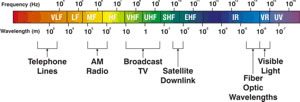
The range of frequencies of electromagnetic radiation from zero to infinity.
Ellipticity
Describes the fact that the core or cladding may be elliptical rather than circular.
EM
Abbreviation for electromagnetic.
EMI (Electromagnetic Interference)
Any electrical or electromagnetic interference that causes undesirable response, degradation, or failure in electronic equipment. Optical fibers neither emit nor receive EMI.
Equilibrium Mode Distribution (EMD)
The steady modal state of a multimode fiber in which the relative power distribution among modes is independent of fiber length.
Erbium-doped Fiber Amplifier (EDFA)
Optical fibers doped with the rare earth element, erbium, which can amplify light in the 1550 nm region when pumped by an external light source.
ESCON
Abbreviation for enterprise systems connection. A duplex optical connector used for computer-to-computer data exchange.
Evanescent Wave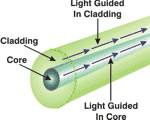
Light guided in the inner part of an optical fiber’s cladding rather than in the core, i.e. the portion of the light wave in the core that penetrates into the cladding.
Excess Loss
In a fiber optic coupler, the optical loss from that portion of light that does not emerge from the nominal operation ports of the device.
Extrinsic Loss
In a fiber interconnection, that portion of loss not intrinsic to the fiber but related to imperfect joining of a connector or splice.
FC/PC
 See FC. A threaded optical connector that uses a special curved polish on the connector for very low backreflection. Good for single-mode or multimode fiber.
See FC. A threaded optical connector that uses a special curved polish on the connector for very low backreflection. Good for single-mode or multimode fiber.
FDDI
 Abbreviation for fiber distributed data interface. 1) A dual counter-rotating ring local area network. 2) A connector used in a dual counter-rotating ring local area network (illustrated).
Abbreviation for fiber distributed data interface. 1) A dual counter-rotating ring local area network. 2) A connector used in a dual counter-rotating ring local area network (illustrated).
FDM
See frequency-division multiplexing.
Ferrule
A rigid tube that confines or holds a fiber as part of a connector assembly.
Fiber Fuse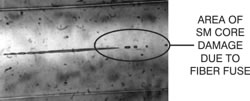
A mechanism whereby the core of a single-mode fiber can be destroyed at high optical power levels.
Fiber Grating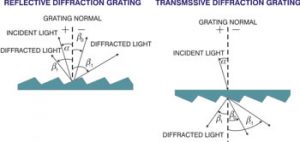
An optical fiber in which the refractive index of the core varies periodically along its length, scattering light in a way similar to a diffraction grating, and transmitting or reflecting certain wavelengths selectively.
Fiber Optic Attenuator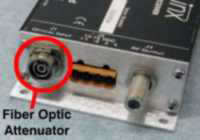
A component installed in a fiber optic transmission system that reduces the power in the optical signal. It is often used to limit the optical power received by the photodetector to within the limits of the optical receiver. A fiber optic attenuator may be an external device, separate from the receiver, or incorporated into the receiver design as illustrated (far left).
Fiber Optic Cable
A cable containing one or more optical fibers.
Fiber Optic Communication System
The transfer of modulated or unmodulated optical energy through optical fiber media which terminates in the same or different media.
Fiber Optic Link
A transmitter, receiver, and cable assembly that can transmit information between two points.
Fiber Optic Span
An optical fiber/cable terminated at both ends which may include devices that add, subtract, or attenuate optical signals.
Fiber Optic Subsystem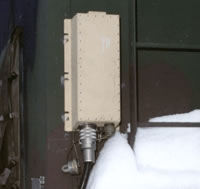
A functional entity with defined bounds and interfaces which is part of a system. It contains solid state and/or other components and is specified as a subsystem for the purpose of trade and commerce.
Fiber-in-the-loop (FITL)
Fiber optic service to a node that is located in a neighborhood.
Fiber-to-the-Curb (FTTC)
Fiber optic service to a node connected by wires to several nearby homes, typically on a block.
Fiber-to-the-Home (FTTH)
Fiber optic service to a node located inside an individual home.
Fibre Channel
An industry-standard specification that originated in Great Britain which details computer channel communications over fiber optics at transmission speeds from 132 Mb/s to 1062.5 Mb/s at distances of up to 10 kilometers.
FOTP (Fiber Optic Test Procedure)
Standards developed and published by the Electronic Industries Association (EIA) under the EIA-RS-455 series of standards.
Fresnel Reflection Loss
Reflection losses at the ends of fibers caused by differences in the refractive index between glass and air. The maximum reflection caused by a perpendicular air-glass interface is about 4% or about -14 dB.
Fused Fiber
A bundle of fibers fused together so they maintain a fixed alignment with respect to each other in a rigid rod.
Fusion Splicer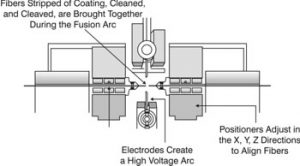
An instrument that permanently bonds two fibers together by heating and fusing them.
FUT
Abbreviation for fiber under test. Refers to the fiber being measured by some type of test equipment.
FWHM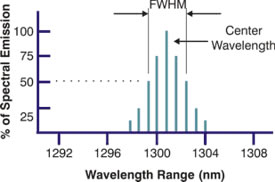
Abbreviation for full width half maximum. Used to describe the width of a spectral emission at the 50% amplitude points. Also known as FWHP (full width half power).
Gap Loss
Loss resulting from the end separation of two axially aligned fibers.
Graded-index Fiber
Optical fiber in which the refractive index of the core is in the form of a parabolic curve, decreasing toward the cladding.
GRIN
Abbreviation for gradient index. Generally refers to the SELFOC lens often used in fiber optics.
Ground Loop Noise
Noise that results when equipment is grounded at points having different potentials thereby creating an unintended current path. The dielectric properties of optical fiber provide electrical isolation that eliminates ground loops.
Group Index
Also called group refractive index. In fiber optics, for a given mode propagating in a medium of refractive index (n), the group index (N), is the velocity of light in a vacuum (c), divided by the group velocity of the mode.
Group Velocity
1) The velocity of propagation of an envelope produced when an electromagnetic wave is modulated by, or mixed with, other waves of different frequencies. 2) For a particular mode, the reciprocal of the rate of change of the phase constant with respect to angular frequency. 3) The velocity of the modulated optical power.
Half-duplex Transmission
A bidirectional link that is limited to one-way transfer of data, i.e., data cannot be sent both ways at the same time. Also referred to as simplex transmission.
Hard-clad Silica Fiber
An optical fiber having a silica core and a hard polymeric plastic cladding intimately bounded to the core.
HFC (Hybrid Fiber Coax)
A transmission system or cable construction (illustrated) that incorporates both fiber optic transmission components and copper coax transmission components.
HFC Network
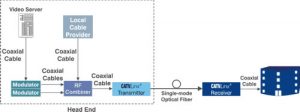 A telecommunication technology in which optical fiber and coaxial cable are used in different sections of the network to carry broadband content. The network allows a CATV company to install fiber from the cable headend to serve nodes located close to business and homes, and then from these fiber nodes, use coaxial cable to individual businesses and homes.
A telecommunication technology in which optical fiber and coaxial cable are used in different sections of the network to carry broadband content. The network allows a CATV company to install fiber from the cable headend to serve nodes located close to business and homes, and then from these fiber nodes, use coaxial cable to individual businesses and homes.
HIPPI
Abbreviation for high performance parallel interface as defined by the ANSI X3T9.3 document, a standard technology for physically connecting devices at short distances and high speeds. Primarily to connect supercomputers and to provide high-speed backbones for local area networks (LANs).
Hydrogen Losses
Increases in fiber connector attenuation that occur when hydrogen diffuses into the glass matrix and absorbs some light.
Index-matching Fluid
A fluid whose index of refraction nearly equals that of the fibers core. Used to reduce Fresnel reflection loss at fiber ends. Also known as index-matching gel.
Infrared Fiber
Colloquially, optical fibers with best transmission at wavelengths of 2 mm or longer, made of materials other than silica glass. See also fluoride glasses.
Insertion Loss
The loss of power that results from inserting a component, such as a connector, coupler (illustrated), or splice, into a previously continuous path.
Interferometer
An instrument that uses the principle of interference of electromagnetic waves for purposes of measurement. Used to measure a variety of physical variables, such as displacement (distance), temperature, pressure, and strain.
Interferometric Intensity Noise (IIN)
Noise generated in optical fiber caused by the distributed backreflection that all fiber generates mainly due to Rayleigh scattering. OTDRs make use of this scattering power to deduce the fiber loss over distance.
Interferometric Sensors
Fiber optic sensors that rely on interferometric detection.
Intermodulation (Mixing)
A fiber nonlinearity mechanism caused by the power dependant refractive index of glass. Causes signals to beat together and generate interfering components at different frequencies. Very similar to four wave mixing.
Intrinsic Losses
Splice losses arising from differences in the fibers being spliced.
ISO
Abbreviation for International Standards Organization. Established in 1947, ISO is a worldwide federation of national standards committees from 140 countries. The organization promotes the development of standardization throughout the world with a focus on facilitating the international exchange of goods and services, and developing the cooperation of intellectual, scientific, technological, and economical activities.
Jacket
The outer, protective covering of the cable. Also called the cable sheath.
Jumper
A short fiber optic cable with connectors on both ends.
Large Core Fiber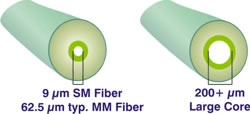
Usually, a fiber with a core of 200 µm or more.
Large Effective Area Fiber (LEAF)
An optical fiber, developed by Corning, designed to have a large area in the core, which carries the light.
Lateral Displacement Loss
The loss of power that results from lateral displacement of optimum alignment between two fibers or between a fiber and an active device.
Launch Fiber
An optical fiber used to couple and condition light from an optical source into an optical fiber. Often the launch fiber is used to create an equilibrium mode distribution in multimode fiber. Also called launching fiber.
L-I Curve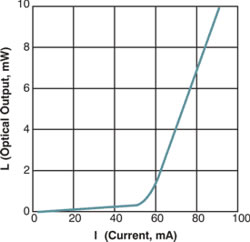
The plot of optical output (L) as a function of current (I) which characterizes an electrical-to-optical converter. A typical L-I curve is shown at right.
Light
In a strict sense, the region of the electromagnetic spectrum that can be perceived by human vision, designated the visible spectrum, and nominally covering the wavelength range of 0.4 µm to 0.7 µm. In the laser and optical communication fields, custom and practice have extended usage of the term to include the much broader portion of the electromagnetic spectrum that can be handled by the basic optical techniques used for the visible spectrum. This region has not been clearly defined, but, as employed by most workers in the field, may be considered to extend from the near-ultraviolet region of approximately 0.3 µm, through the visible region, and into the mid-infrared region to 30 µm.
Light Piping
Use of optical fibers to illuminate.
Lightguide
Synonym for optical fiber.
Loose-tube
A type of fiber optic cable construction where the fiber is contained within a loose tube in the cable jacket.
Loss Budget
An accounting of overall attenuation in a system. See optical link loss budget.
Lossless Compression
1) Reduction of the storage size of digital data by employing one or more appropriate algorithms in such a way that the data can be recover without loosing integrity. 2) Reduction of the amount of data that needs to be transmitted per unit time though an analogous real-time process that does not compromise the ability to completely restore the data.
Macrobending
In a fiber, all macroscopic deviations of the fiber’s axis from a straight line, that will cause light to leak out of the fiber, causing signal attenuation.
Mass Splicing
Splicing of many fibers in a cable.
Material Dispersion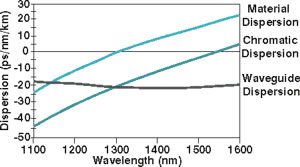
Dispersion resulting from the different velocities of each wavelength in a material.
Mechanical Splice
An optical fiber splice accomplished by fixtures or materials, rather than by thermal fusion. The capillary splice, illustrated, is one example of a mechanical splice.
Microbending
Mechanical stress on a fiber that introduces local discontinuities, which results in light leaking from the core to the cladding by a process called mode coupling.
MIL-SPEC
Abbreviation for military specification. Performance specifications issued by the Department of Defense that must be met in order to pass a MIL-STD.
MIL-STD
Abbreviation for military standard. Standards issued by the Department of Defense.
Minimum Bend Radius
The smallest radius an optical fiber or fiber cable can bend before increased attenuation or breakage occurs.
Misalignment Loss
The loss of power resulting from angular misalignment, lateral displacement, and fiber end separation.
Modal Dispersion
See multimode dispersion.
Modal Noise
Noise that occurs whenever the optical power propagates through mode-selective devices. It is usually only a factor with laser light sources.
Mode
A single electromagnetic wave traveling in a fiber.
Mode Coupling
The transfer of energy between modes. In a fiber, mode coupling occurs until equilibrium mode distribution (EMD) is reached.
Mode Evolution
The dynamic process a multilongitudinal mode laser undergoes whereby the changing distribution of power among the modes creates a continuously changing envelope of the laser’s spectrum.
Mode Field Diameter (MFD)
A measure of distribution of optical power intensity across the end face of a single-mode fiber.
Mode Filter
A device that removes higher-order modes to simulate equilibrium mode distribution. A mode filter is most easily constructed.
Mode Stripper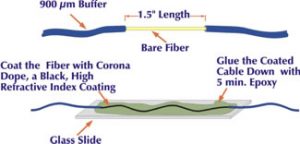
A device that removes cladding modes.
Multimode (MM) Fiber
An optical fiber that has a core large enough to propagate more than one mode of light The typical diameter is 62.5 micrometers.
Multimode Dispersion
Dispersion resulting from the different transit lengths of different propagating modes in a multimode optical fiber. Also called modal dispersion.
Multiple Reflection Noise (MRN)
The fiber optic receiver noise resulting from the interference of delayed signals from two or more reflection points in a fiber optic span. Also known as multipath interference.
Multiplexer
A device that combines two or more signals into one output.
Multiplexing
The process by which two or more signals are transmitted.
NA Mismatch Loss
 The loss of power at a joint that occurs when the transmitting half has a numerical aperture greater than the NA of the receiving half. The loss occurs when coupling light from a source to fiber, from fiber to fiber, or from fiber to detector.
The loss of power at a joint that occurs when the transmitting half has a numerical aperture greater than the NA of the receiving half. The loss occurs when coupling light from a source to fiber, from fiber to fiber, or from fiber to detector.
National Electric Code® (NEC)
A standard governing the use of electrical wire, cable and fixtures installed in buildings; developed by the American National Standards Institute (ANSI), sponsored by the National Fire Protection Association (NFPA), identified by the description ANSI/NFPA 70-1990.
NCTA
Abbreviation for National Cable Television Association. The major trade association for the cable television industry.
NDSF
See non dispersion-shifted fiber.
Near Infrared
The part of the infrared near the visible spectrum, typically 700 nm to 1500 nm or 2000 nm; it is not rigidly defined.
Near-end Crosstalk (NEXT, RN)
The optical power reflected from one or more input ports, back to another input port. Also known as isolation directivity.
NEMA
Abbreviation for National Electrical Manufacturers Association. Organization responsible for the standardization of electrical equipment, enabling consumers to select from a range of safe, effective, and compatible electrical products.
Node
1) A terminal of any branch in network topology or an interconnection common to two or more branches in a network. 2) One of the switches forming the network backbone in a switch network. 3) A point in a standing or stationary wave at which the amplitude is a minimum.
Non Zero-dispersion-shifted Fiber (NZ-DSF)
A dispersion-shifted single-mode fiber that has the zero-dispersion wavelength near the 1550 nm window, but outside the window actually used to transmit signals. This strategy maximizes bandwidth while minimizing fiber nonlinearities.
Numerical Aperture (NA)
 The light-gathering ability of a fiber; the maximum angle to the fiber axis at which light will be accepted and propagated through the fiber. NA = sin a, where a is the acceptance angle. NA also describes the angular spread of light from a central axis, as in exiting a fiber, emitting from a source, or entering a detector.
The light-gathering ability of a fiber; the maximum angle to the fiber axis at which light will be accepted and propagated through the fiber. NA = sin a, where a is the acceptance angle. NA also describes the angular spread of light from a central axis, as in exiting a fiber, emitting from a source, or entering a detector.
O/E
![]() Abbreviation for optical-to-electrical converter. A device used to convert optical signals to electrical signals. Also known as OEC.
Abbreviation for optical-to-electrical converter. A device used to convert optical signals to electrical signals. Also known as OEC.
OADM
See optical add/drop multiplexer.
OAM
Abbreviation for operation, administration, and maintenance. Refers to telecommunications networks.
OAN
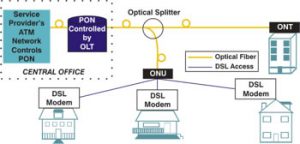 Abbreviation for optical access network. A network technology, based on passive optical networks (PONs), that includes an optical switch at the central office, an intelligent optical terminal at the customer’s premises, and a passive optical network between the two, allowing services providers to deliver fiber-to-the-home while eliminating the expensive electronics located outside the central office.
Abbreviation for optical access network. A network technology, based on passive optical networks (PONs), that includes an optical switch at the central office, an intelligent optical terminal at the customer’s premises, and a passive optical network between the two, allowing services providers to deliver fiber-to-the-home while eliminating the expensive electronics located outside the central office.
OCH
See optical channel.
OC-x
Abbreviation for optical carrier. A carrier rate specified in the SONET standard.
ODN
Abbreviation for optical distribution network. Term for optical networks being developed for interactive video, audio, and data distribution.
OEIC
Abbreviation for opto-electronic integrated circuit. An integrated circuit that includes both optical and electrical elements.
OEM
Abbreviation for original equipment manufacturer. The manufacturer of any device that is designed and built to be distributed under the label of another company.
OLT
Abbreviation for optical line termination. Optical network elements that terminate a line signal.
OLTS
Abbreviation for optical loss test set. A source and optical power meter combined used to measure optical loss.
OMS
 Abbreviation for optical multiplex section. A section of a DWDM system that incorporates an optical add/drop multiplexer.
Abbreviation for optical multiplex section. A section of a DWDM system that incorporates an optical add/drop multiplexer.
ONI
Abbreviation for optical network interface. A device used in an optical distribution network to connect two parts of that network.
ONT
Abbreviation for optical network termination. Optical network element that terminates a line signal in installations where the fiber extends into the customer premises.
ONU
Abbreviation for optical network unit. A network element that is part of a fiber-in-the-loop system.
OOI
Abbreviation for open optical interface. A point at which an optical signal is passed from one equipment medium to another without conversion to an electrical signal.
Open Systems Interconnection (OSI)
Pertaining to the logical structure for communications networks standardized by the International Organization for Standardization (ISO).
Optical Add/Drop Multiplexer (OADM)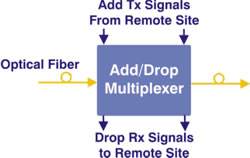
A device which adds or drops individual wavelengths from a DWDM system.
Optical Amplifier
A device that amplifies an input optical signal without converting it into electrical form. The best developed are optical fibers doped with the rare earth element, erbium. See also EDFA.
Optical Bandpass
The range of optical wavelengths which can be transmitted through a component.
Optical Channel
An optical wavelength band for WDM optical communications.Optical Channel Spacing
The wavelength separation between adjacent WDM channels.
Optical Channel Width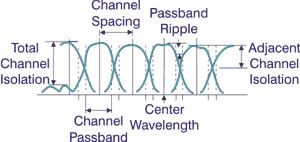
The optical wavelength range of a channel.
Optical Continuous Wave Reflectometer (OCWR)
An instrument used to characterize a fiber optic link wherein an unmodulated signal is transmitted through the link, and the resulting light scattered and reflected back to the input is measured. Useful in estimating component reflectance and link optical return loss.
Optical Directional Coupler (ODC)
A component used to combine and separate optical power.
Optical Fall Time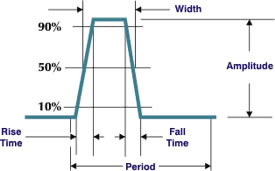
The time interval for the falling edge of an optical pulse to transition from 90% to 10% of the pulse amplitude. Alternatively, values of 80% and 20% may be used.
Optical Fiber
A glass or plastic fiber that has the ability to guide light along its axis. The three parts of an optical fiber are the core, the cladding, and the coating or buffer.
Optical Isolator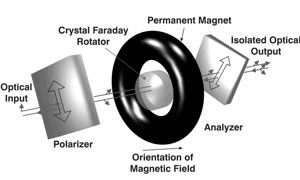
A component used to block out reflected and unwanted light. Also called an isolator.
Optical Link Loss Budget
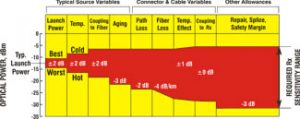 The range of optical loss over which a fiber optic link will operate and meet all specifications. The loss is relative to the transmitter output power and affects the required receiver input power.
The range of optical loss over which a fiber optic link will operate and meet all specifications. The loss is relative to the transmitter output power and affects the required receiver input power.
Optical Path Power Penalty
 The additional loss budget required to account for degradations due to reflections, and the combined effects of dispersion resulting from intersymbol interference, mode-partition noise, and laser chirp.
The additional loss budget required to account for degradations due to reflections, and the combined effects of dispersion resulting from intersymbol interference, mode-partition noise, and laser chirp.
Optical Power Meter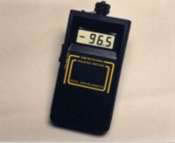
An instrument that measures the amount of optical power present at the end of a fiber or cable.
Optical Pump Laser
A shorter wavelength laser used to pump a length of fiber with energy to provide amplification at one or more longer wavelengths. See also EDFA.
Optical Return Loss (ORL)
The ratio (expressed in dB) of optical power reflected by a component or an assembly to the optical power incident on a component port when that component or assembly is introduced into a link or system.
Optical Rise Time
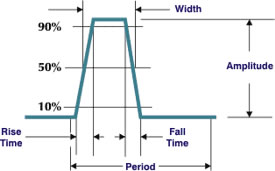 The time interval for the rising edge of an optical pulse to transition from 10% to 90% of the pulse amplitude. Alternatively, values of 20% and 80% may be used.
The time interval for the rising edge of an optical pulse to transition from 10% to 90% of the pulse amplitude. Alternatively, values of 20% and 80% may be used.
Optical Signal-to-Noise-Ratio (OSNR)
The optical equivalent of SNR.
Optical Spectrum Analyzer (OSA)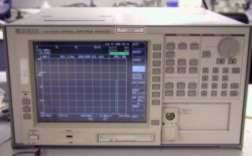
A device that allows the details of a region of an optical spectrum to be resolved. Commonly used to diagnose DWDM systems.
Optical Waveguide
Another name for optical fiber.
OSA
See optical spectrum analyzer.
OSNR
See optical signal-to-noise ratio.
OTDR (Optical Time Domain Reflectometer)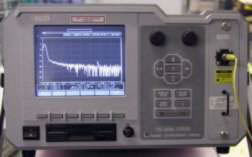
An instrument that locates faults in optical fibers or infers attenuation by backscattered light measurements.
Outside Plant (OSP)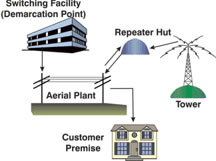
In telephony, all cables, conduits, ducts, poles, towers, repeaters, repeater huts, and other equipment located between a demarcation point in a switching facility and a demarcation point in another switching facility or customer premises.
OXC
Abbreviation for optical cross-connect. See cross-connect.
Passive Device
Any device that does not require a source of energy for its operation. Examples include electrical resistors or capacitors, diodes, optical fiber (photo), cable, wires, glass, lenses, and filters.
PC
Abbreviation for physical contact. Refers to an optical connector that allows the fiber ends to physically touch. Used to minimize backreflection and insertion loss.
Pigtail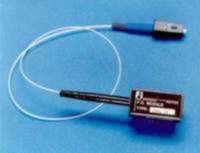
A short optical fiber permanently attached to a source, detector, or other fiber optic device at one end and an optical connector at the other.
Plastic Fiber
An optical fiber having a plastic core and plastic cladding.
Plenum
The air handling space between walls, under structural floors, and above drop ceilings, which can be used to route intrabuilding cabling.
Plenum Cable
A cable whose flammability and smoke characteristics allow it to be routed in a plenum area without being enclosed in a conduit.
Point-to-Point Transmission
Transmission between two designated stations.
Polarization Maintaining Fiber
Fiber designed to propagate only one polarization of light that enters it.
Polarization Mode Dispersion (PMD)
 Polarization mode dispersion is an inherent property of all optical media. It is caused by the difference in the propagation velocities of light in the orthogonal principal polarization states of the transmission medium. The net effect is that if an optical pulse contains both polarization components, then the different polarization components will travel at different speeds and arrive at different times, smearing the received optical signal.
Polarization mode dispersion is an inherent property of all optical media. It is caused by the difference in the propagation velocities of light in the orthogonal principal polarization states of the transmission medium. The net effect is that if an optical pulse contains both polarization components, then the different polarization components will travel at different speeds and arrive at different times, smearing the received optical signal.
PON
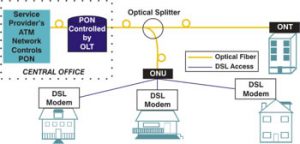 Abbreviation for passive optical network. A broadband fiber optic access network that uses a means of sharing fiber to the home without running individual fiber optic lines from an exchange point, telco CO, or a CATV headend and the subscriber’s home.
Abbreviation for passive optical network. A broadband fiber optic access network that uses a means of sharing fiber to the home without running individual fiber optic lines from an exchange point, telco CO, or a CATV headend and the subscriber’s home.
Preform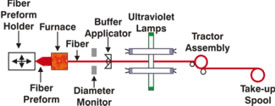
The glass rod from which optical fiber is drawn.
Profile Dispersion
Dispersion attributed to the variation of refractive index contrast with wavelength.
ps
Abbreviation for picosecond. One trillionth of a second or 10-12 seconds.
Radiation-hardened Fiber
An optical fiber made with core and cladding materials that are designed to recover their intrinsic value of attenuation coefficient, within an acceptable time period, after exposure to a radiation pulse.
Rays
Lines that represent the path taken by light.
Receiver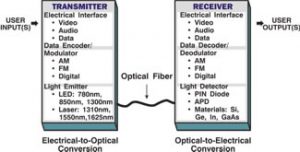
A terminal device that includes a detector and signal processing electronics. It functions as an optical-to-electrical converter.
Receiver Overload
The maximum acceptable value of average received power for an acceptable BER or performance.
Receiver Sensitivity
The minimum acceptable value of received power needed to achieve an acceptable BER or performance. It takes into account power penalties caused by use of a transmitter with worst-case values of extinction ratio, jitter, pulse rise times and fall times, optical return loss, receiver connector degradations, and measurement tolerances. The receiver sensitivity does not include power penalties associated with dispersion, or backreflections from the optical path; these effects are specified separately in the allocation of maximum optical path penalty. Sensitivity usually takes into account worst-case operating and end-of-life (EOL) conditions.
Refraction
The changing of direction of a lightwave in passing through a boundary between two dissimilar media, or in a graded-index medium where refractive index is a continuous function of position.
Refractive Index
A property of optical materials that relates to the speed of light in the material versus the speed of light in a vacuum.
Refractive Index Gradient
The description of the value of the refractive index as a function of distance from the optical axis along an optical fiber diameter. Also called refractive index profile.
Residual Loss
The loss of the attenuator at the minimum setting of the attenuator.
Return Loss
See optical return loss.
Ribbon Cables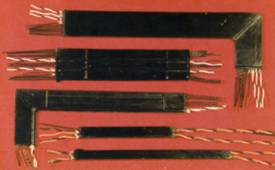
Cables in which many fibers and/or copper wires are embedded in a plastic material in parallel, forming a flat ribbon-like structure.
SC
 Abbreviation for subscription channel connector. A push-pull type of optical connector that features high packing density, low loss, low backreflection, and low cost.
Abbreviation for subscription channel connector. A push-pull type of optical connector that features high packing density, low loss, low backreflection, and low cost.
Scattering
 The change of direction of light rays or photons after striking small particles. It may also be regarded as the diffusion of a light beam caused by the inhomogeneity of the transmitting material.
The change of direction of light rays or photons after striking small particles. It may also be regarded as the diffusion of a light beam caused by the inhomogeneity of the transmitting material.
Self-phase modulation (SPM)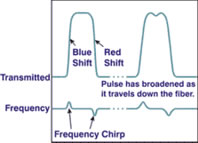
A fiber nonlinearity caused by the nonlinear index of refraction of glass. The index of refraction varies with optical power level causing a frequency chirp which interacts with the fiber’s dispersion to broaden the pulse.
Semiconductor Optical Amplifier (SOA)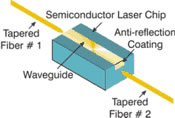
A laser diode without end mirrors coupled to the fibers on both ends. Light coming in either fiber is amplified by a single pass through the laser diode. An alternative to EDFAs.
Sheath
An outer protective layer of a fiber optic cable. Also called the cable jacket.
Silica Glass
Glass made mostly of silicon dioxide, SiO2, used in conventional optical fibers.
Simplex
Single element (e.g., a simplex connector is a single-fiber connector).
Simplex Cable
A term sometimes used for a single-fiber cable.
Simplex Transmission
Transmission in one direction only. Also referred to as half-duplex transmission.
Single-mode (SM) Fiber
A small-core optical fiber through which only one mode will propagate. The typical diameter is 8-9 microns.
Single-mode Optical Loss Test Set (SMOLTS)
An optical loss test set for use with single-mode fiber.
SMA
A threaded type of optical connector. One of the earliest optical connectors to be widely used. Offers poor repeatability and performance.
Smart Structures
Also smart skins. Materials containing sensors (fiber optic or other types) to measure their properties during fabrication and use.
SMF
Abbreviation for single-mode fiber.
Source
In fiber optics, a transmitting LED or laser diode, or an instrument that injects test signals into fibers.
Splice
A permanent connection of two optical fibers through fusion or mechanical means.
Splitter
see Coupler.
Splitting Ratio
The ratio of power emerging from two output ports of a coupler.
ST
Abbreviation for straight tip connector. Popular fiber optic connector originally developed by AT&T.
Stabilized Light Source
An LED or laser diode that emits light with a controlled and constant spectral width, center wavelength, and peak power with respect to time and temperature.
Step-index Fiber
Fiber that has a uniform index of refraction throughout the core that is a step below the index of refraction in the cladding.
Stimulated Brillouin Scattering (SBS)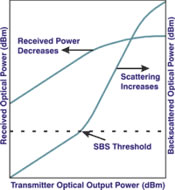
The easiest fiber nonlinearity to trigger. When a powerful light wave travels through a fiber it interacts with acoustical vibration modes in the glass. This causes a scattering mechanism to be formed that reflects much of the light back to the source.
Stimulated Raman Scattering (SRS)
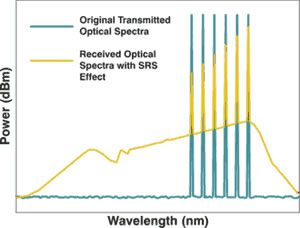 A fiber nonlinearity similar to SBS but having a much higher threshold. This mechanism can also cause power to be robbed from shorter wavelength signals and provide gain to longer wavelength signals.
A fiber nonlinearity similar to SBS but having a much higher threshold. This mechanism can also cause power to be robbed from shorter wavelength signals and provide gain to longer wavelength signals.
Strength Member
The part of a fiber optic cable composed of aramid yarn, steel strands, or fiberglass filaments that increase the tensile strength of the cable.
Submarine Cable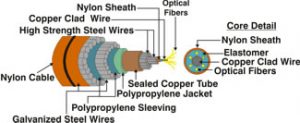
A cable designed to be laid underwater.
Supertrunk
A cable that carries several video channels between facilities of a cable television company.
Tap Loss
In a fiber optic coupler, the ratio of power at the tap port to the power at the input port.
Tee Coupler
A three-port optical coupler.
Throughput Loss
In a fiber optic coupler, the ratio of power at the throughput port to the power at the input port.
Throughput Port
In a coupler where the splitting ratio between output ports is not equal, the output port containing the greater power.
TICL
Abbreviation for temperature induced cable loss. Optical loss as a result of extreme temperatures outside a fiber optic cable’s environmental specifications.
Tight-Buffer
A material tightly surrounding a fiber in a cable, holding it rigidly in place.
Total Internal Reflection
The reflection that occurs when light strikes an interface at an angle of incidence (with respect to the normal) greater than the critical angle.
Transducer
A device that converts energy from one form to another, such as optical energy to electrical energy.
Transmitter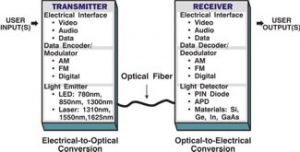
A device that includes a source and driving electronics. It functions as an electrical-to-optical converter.
Twisted Pair (TP) Cable
A cable made up of one or more separately insulated twisted wire pairs, none of which is arranged with another to form quads.
UL
Abbreviation for Underwriter’s Laboratory. An organization that tests product safety for a wide variety of products. UL approved products carry the symbol shown at right.
Unidirectional
Operating in one direction only.
UTP Cabling
Unshielded Twisted Pair.
W
Abbreviation for Watt. A linear measurement of optical power, usually expressed in milliwatts, microwatts, and nanowatts.
WAN
See Wide Area Network.
Waveguide
A material medium that confines and guides a propagating electromagnetic wave. In the microwave regime, a waveguide normally consists of a hollow metallic conductor, generally rectangular, elliptical, or circular in cross-section. This type of waveguide may, under certain conditions, contain a solid or gaseous dielectric material. In the optical regime, a waveguide used as a long transmission line consists of a solid dielectric filament (fiber), usually circular in cross-section. In integrated optical circuits an optical waveguide may consist of a thin dielectric film. In the RF regime, ionized layers of the stratosphere and the refractive surfaces of the troposphere may also serve as a waveguide.
Waveguide Coupler
A coupler in which light gets transferred between planar waveguides.
Waveguide Dispersion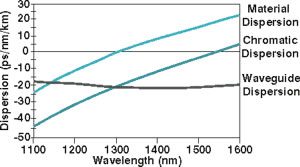
The part of chromatic dispersion arising from the different speeds light travels in the core and cladding of a single-mode fiber (i.e., from the fiber’s waveguide structure).
Wavelength
The distance between points of corresponding phase of two consecutive cycles of a wave. The wavelength relates to the propagation velocity, and the frequency, by:
Wavelength Adapter
A device which receives one wavelength and outputs a second wavelength, usually to take a standard signal and convert it to an ITU wavelength.
Wavelength Isolation
A WDM’s isolation of a light signal in the desired optical channel from the unwanted optical channels. Also called far-end crosstalk.
Wavelength Selective Coupler
A device which couples the pump laser wavelength to the optical fiber while filtering out all other unwanted wavelengths. Used in erbium-doped fiber amplifiers.
Wavelength-division Multiplexing (WDM)
Sending several signals through one fiber with different wavelengths of light.
Wideband
Possessing large bandwidth.
Wireless
A network or terminal that uses electromagnetic waves, such as RF, infrared, laser, visible light, and acoustic energy, not wires, for telecommunications.
WWW (World Wide Web)
The collection of millions of graphical pages that heavily utilize HTML to provide access to information. One of the key components of the Internet.
X-Band
The frequency range between 8.0 and 8.4 GHz.
XC
See cross-connect.
X-Series Recommendations
Sets of data telecommunications protocols and interfaces defined by the ITU.
Zero-dispersion Slope
In single-mode fiber, the rate of change of dispersion with respect to wavelength, at the fiber’s zero-dispersion wavelength.
Zero-dispersion Wavelength (l0)
In a single-mode optical fiber, the wavelength at which material dispersion and waveguide dispersion cancel one another. The wavelength of maximum bandwidth in the fiber. Also called zero-dispersion point.
Zipcord
A two-fiber cable consisting of two single fiber cables having conjoined jackets. A zipcord cable can be easily divided by slitting and pulling the conjoined jackets apart.

